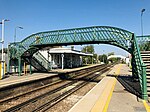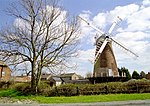Willingdon and Jevington
Civil parishes in East SussexEngvarB from July 2016Wealden District

Willingdon and Jevington is one of the civil parishes in the Wealden District of East Sussex, England. The two villages lie one mile (1.6 km) south of Polegate. Willingdon is part of the built-up area which is Eastbourne, and lies on the main A22 road, whilst Jevington is on a minor road leading to Friston. The civil parish was formed on 1 April 1999 from "Jevington" and "Willingdon" parishes. In addition under the name of Willingdon it is also an electoral ward.
Excerpt from the Wikipedia article Willingdon and Jevington (License: CC BY-SA 3.0, Authors, Images).Willingdon and Jevington
Wealden Park, Wealden Willingdon and Jevington
Geographical coordinates (GPS) Address Nearby Places Show on map
Geographical coordinates (GPS)
| Latitude | Longitude |
|---|---|
| N 50.8 ° | E 0.26 ° |
Address
Wealden Park
Wealden Park
BN22 0JF Wealden, Willingdon and Jevington
England, United Kingdom
Open on Google Maps






